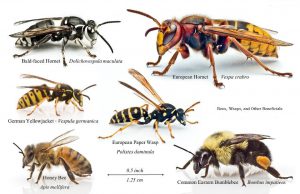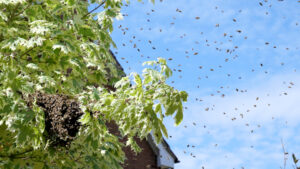Swarms
Quick Link – if you are SURE you have a honey bee swarm and need to contact a bee keeper urgently
Click here to go to the BBKA Swarm Collectors website. (You’ll still need to scroll down the BBKA’s page past their information on what is a honey bee swarm)
What is a swarm?
Swarming is the process by which a new honey bee colony is formed when the queen bee leaves the colony with a large group of worker bees. In the prime swarm, about 60% of the worker bees leave the original hive location with the old queen. This swarm can contain thousands to tens of thousands of bees. Swarming is mainly a spring phenomenon, usually within a two- or three-week period depending on the locale, but occasional swarms can happen throughout the producing season. Secondary swarms, called casts, may also occur. These are smaller than the first, or prime, swarm and are headed by a virgin queen.
Swarming is honey bee colonies’ natural means of reproduction. In the process of swarming the original single colony reproduces to two and sometimes more colonies.
Do you need help with a swarm?
Collection of swarms is coordinated by the British Beekeepers Association (BBKA). All registered swarm collectors are identified on a map on the BBKA website and you should use this to find someone near to where you live to collect the swarm. If the first person you contact cannot deal with your swarm, try someone else. Generally, swarms don’t stay in one place for more than a few hours, so speed is of the essence. A link to the BBKA map is given below.
However before you consider contacting a local swarm collector please read the ‘Is the swarm honey bees?’ section below carefully and try and identify whether the swarm you have are honey bees as swarm collectors are unable to help remove any other insects such as solitary (bumble) bees and wasps.
Swarm FAQ’s
Firstly we have some FAQs about swarms and collecting swarms:
- Yes, on most occasions a swarm of honey bees can be collected by a beekeeper who wants to increase their stock of bees. The exception to this is when:
- there is no beekeeper available to collect the swarm
- the bees you have are not honey bees – see how to identify honey bees
- the honey bees have settled in an inaccessible place, for example if they are deep inside a chimney – we can advise about this
A swarm of bees can appear very alarming, however if you exercise a little caution they are normally of no danger to humans or animals.
If a beekeeper is available to collect your swarm no charge is made for collection. Most beekeeper associations will however encourage a charitable donation to go towards the costs of the call-out and their time. The following document describes this for swarm collectors who are members of OBKA:
If you go to the following webpage you will find information on honey bee swarms and a map with swarm collectors in your area.
Before you call, please check the BBKA website which will help you differentiate between honey bee swarms and other types of bees/wasps/hornets. Please note that beekeepers can only deal with honey bees and, as we are a charity run by volunteers, we cannot guarantee a response.
Swarms are generally harmless, i.e. they will not sting you, unless they are provoked. Please leave it alone until contacted by a swarm collector. Do not let children or pets interfere with it. Generally, swarms collect in one place for a day or so while they find a suitable new home. Once they have decided where to live, they will leave quickly in a large swarm cloud. This is not dangerous but is best avoided.
If the swarm does not move for several days, the bees may become more aggressive as they run out of food.
If they are honey bees but cannot be collected by a local beekeeper you could try contacting the Environmental Health Department of your local district council. Whilst councils don’t consider bees (whether honey or not) as pests they do provide control services, that vary between councils, so might be able to deal with your visitors should they turn out not be honey bees but rather some pest.
And some FAQs regarding finding bees in and around properties:
You should be aware that removing bees from a building structure is especially difficult and may not be successful. If the bees are honey bees they should be removed because the nest site is permanent and can become very large. For other bee species and wasps this may not be necessary because the nest is small and they occupy the site for one season and then die.
To provide advice we need to determine if the bees are honey bees:
- The BBKA.org.uk website gives advice on identifying bees under their swarm page. However, if the bees cannot be seen close-up, it may not be possible to identify them visually.
- If the bees arrived recently and they were seen to arrive did they appear as a swarm with thousands of bees? If so , they probably are honey bees.
- Can you see bees entering and leaving? Roughly, on a warm and sunny afternoon, how many are leaving and entering each minute, e.g. 1 per minute, 10 per minute (easily counted), 100 per minute (too many to count)? High numbers suggest honey bees; low numbers, other bee species.
If you are sure the bees are honey bees they should be removed. Most swarm collectors associated with OBKA or other beekepeing organisations are not able to work at height or dismantle building structures due to insurance restrictions. We therfore recommend you contact a specialist pest controller. Our beekeepers may be able to assist, for example by offering to rehouse a recovered colony. Please discuss this with the pest controller.
If you are sure the bees are not honey bees, we suggest leaving them alone. The colony will die in autumn. Before doing this they make several queens that hibernate over winter and start a new colony in the spring in a new location.
There are several UK bee species that burrow into walls, such as the red mason bee (Osmia bicornis). These bees are excellent pollinators for many crops and are under threat from habitat loss, inappropriate insecticide use and changes to climate. Generally, they will not sting unless severely provoked and they don’t burrow deeply.
Beekeepers look after a different species, the honey bee (Apis melliferia) and are unable to help people affected by other bee species, wasps or hornets. As a bee charity, we have a policy of not harming any type of bee where practicable.
There are several helpful web articles on mason bees which should help you understand their benefits, life cycle and threat to both your property and to people. At the end of summer, the bee raises new queens and the bees will stop using their current nest site. The new queens hibernate to start a new colony next spring.
Relocation is not a practical option. If you still wish to destroy them, we suggest contacting a pest control company.
With high certainty, bees nesting under a shed or on the ground will be a type of bumble bee and not a honey bee. Beekeepers are only able to assist with the removal of honey bees. If you have any doubts on identification, please examine the swarm page on the BBKA website:
Swarm removal | British Beekeepers Association
If the bees are not causing a problem, I would suggest leaving them alone as they are valuable pollinators. Bumble bees occupy a nest for one summer and then die, leaving a few queens that hibernate to start a new nest next spring. By the end of the year they will have gone. Generally, bumble bees will not sting unless they are provoked, for example by trying to remove or destroy the nest.
If you feel that they must be removed you will have to contact a pest control company. They will destroy them rather than attempt to relocate them.
With high certainty, bees in a bird box will be a type of bumblebee, rather than a honey bee (the bees kept by beekeepers that make honey). Beekeepers can only help with the removal of honey bees. A bird box is too small for a honey bee colony and is very unlikely to have been selected by honey bees as a nest site as the space is just too small for a honey bee colony.
To determine if the bees if the bees are honey bees there is identification information on the British Beekeepers Association website at
Swarm removal | British Beekeepers Association
What can be done about them?
That depends on whether they are a nuisance. If people are getting stung, you may need to consider removal. OBKA may be able to help remove honey bees but not bumble bees. However, if the bees are not causing a problem, we advise leaving them alone as they are valuable pollinators. Bumble bees occupy a nest for one summer and then die. By the end of the year they will have gone.
If you go to the following webpage you will find information on honey bee swarms and a map with swarm collectors in your area.
Before you call, please check the BBKA website which will help you differentiate between honey bee swarms and other types of bees/wasps/hornets. Please note that beekeepers can only deal with honey bees and, as we are a charity run by volunteers, we cannot guarantee a response.
Swarms are generally harmless, i.e. they will not sting you, unless they are provoked. Please leave it alone until contacted by a swarm collector. Do not let children or pets interfere with it. Generally, swarms collect in one place for a day or so while they find a suitable new home. Once they have decided where to live, they will leave quickly in a large swarm cloud. This is not dangerous but is best avoided.
If the swarm does not move for several days, the bees may become more aggressive as they run out of food.
Identifying honey bees – and link to swarm collector’s map

To determine if the swarm that you need help removing is honey bees please follow this identification check-list on the British Beekeepers Association website.
At the end of the identification check-list is the map of swarm collectors. Enter in your postcode and you will see details of swarm collectors nearest to you.
